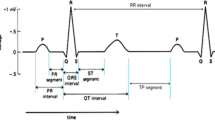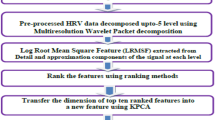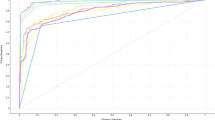Abstract
This article presents an automated algorithm which combines ranking method with generalized discriminant analysis \((\mathrm{GDA})\) and1-norm extreme learning machine \((1-\mathrm{NELM})\) to detect coronary artery disease (CAD) subject. For detection of CAD, the eleven nonlinear attributes like correlation dimension \((\mathrm{CD})\), poincare plot, multivariate largest Lyapunov exponent \((\mathrm{MLLE})\), hurst exponent \((\mathrm{HE})\), Lempel–Ziv \((\mathrm{LZ})\), sample entropy (\(\mathrm{SampEn}\)), dispersion entropy \((\mathrm{DispEn}),\) improved permutation entropy (IPE), adaptive multiscale PE \((\mathrm{AMPE})\), multifractal detrended fluctuation analysis \((\mathrm{MFDFA}\)) and cumulative bi-correlation \((\mathrm{CBC})\) have been retrieved from heart rate variability (HRV) signal. For this analysis, the HRV data have been taken from publicly available database of healthy elderly (ELY), young \((\mathrm{YNG})\) and \(\mathrm{CAD}\) subjects. The rank of attributes have been calculated using ranking methods such as \(\mathrm{Fisher},\) \(\mathrm{Wilcoxon}\), Entropy, \(\mathrm{Bhattacharya}\), and receiver operating characteristic \((\mathrm{ROC})\). The experiments were carried out numerically through the combination of database sets YNG-ELY, \(\mathrm{YNG}-\mathrm{CAD}\) and \(\mathrm{ELY}-\mathrm{CAD}\) subjects. The numerical results have shown that ROC with GDA and \(1-\mathrm{NELM}\) approach achieved an accuracy of 99.76 ± 0.14, 99.87 ± 0.12 and 100 ± 0 respectivly for \(\mathrm{YNG}-\mathrm{CAD},\mathrm{ YNG}-\mathrm{ELY}\) and \(\mathrm{ELY}-\mathrm{CAD}\) groups. The Fisher with GDA and 1-NELM; and Bhattacharya with \(\mathrm{GDA}\) and \(1-\mathrm{NELM}\) approach achieved an accuracy of 100 ± 0 for all considered datasets. The proposed method also achieved very good generalization performance with the smallest 1-norm root mean square error (RMSE) and less execution validation time as compared to \(\mathrm{support vector machine}\) \((\mathrm{SVM})\) \(\mathrm{and probabilistic neural network}\) \((\mathrm{PNN})\).






Similar content being viewed by others

References
Aboy M, Hornero R, Abasolo D, Álvarez D (2006) Interpretation of the Lempel-Ziv complexity measure in the context of biomedical signal analysis. IEEE Trans Biomed Eng 53(11):2282–2288. https://doi.org/10.1109/TBME.2006.883696
Acharya R, Kannathal UN, Krishnan SM (2004) Comprehensive analysis of cardiac health using heart rate signals. Physiol Meas 25(5):1139–1151
Alizadehsani R et al (2019) Machine learning-based coronary artery disease diagnosis: a comprehensive review. Comput Biol Med 111:103346. https://doi.org/10.1016/j.compbiomed.2019.103346
Asl BM, Setarehdan SK, Mohebbi M (2008) Support vector machine-based arrhythmia classification using reduced features of heart rate variability signal. Artif Intell Med 44(1):51–64. https://doi.org/10.1016/j.artmed.2008.04.007
Azami H, Escudero J (2016) Improved multiscale permutation entropy for biomedical signal analysis: Interpretation and application to electroencephalogram recordings. Biomed Signal Process Control 23:28–41. https://doi.org/10.1016/j.bspc.2015.08.004
Azami H, Rostaghi M, Abasolo D, Escudero J (2017) Refined composite multiscale dispersion entropy and its application to biomedical signals. IEEE Trans Biomed Eng 64(12):2872–2879. https://doi.org/10.1109/TBME.2017.2679136
Babaoglu I, Findik O, Ülker E (2010) A comparison of feature selection models utilizing binary particle swarm optimization and genetic algorithm in determining coronary artery disease using support vector machine. Expert Syst Appl 37(4):3177–3183. https://doi.org/10.1016/j.eswa.2009.09.064
Babaoğlu I, Fındık O, Bayrak M (2010) Effects of principle component analysis on assessment of coronary artery diseases using support vector machine. Expert Syst Appl 37(3):2182–2185. https://doi.org/10.1016/j.eswa.2009.07.055
Babaoglu I, Findik O, Ulker E (2010) A comparison of feature selection models utilizing binary particle swarm optimization and genetic algorithm in determining coronary artery disease using support vector machine. Expert Syst Appl 37(4):3177–3183. https://doi.org/10.1016/j.eswa.2009.09.064
Balasundaram S, Gupta D, and Kapil (2014) 1-Norm extreme learning machine for regression and multiclass classification using Newton method. Neurocomputing https://doi.org/10.1016/j.neucom.2013.03.051.
Bartlett PL (1998) The sample complexity of pattern classification with neural networks: The size of the weights is more important than the size of the network. IEEE Trans Inf Theory 44(2):525–536. https://doi.org/10.1109/18.661502
Bin Huang G, Wang DH, Lan Y (2011) Extreme learning machines: A survey. Int J Mach Learn Cybern 2(2):107–122
Bravi A, Longtin A, Seely AJE (2011) Review and classification of variability analysis techniques with clinical applications. Biomed Eng Online 10:1–27. https://doi.org/10.1186/1475-925X-10-90
Butchart A, Mikton C, Dahlberg LL, Krug EG (2015) Global status report on violence prevention 2014. Inj Prev 21(3):213–213. https://doi.org/10.1136/injuryprev-2015-041640
Castiglioni P, Lazzeroni D, Coruzzi P, Faini A (2018) Multifractal-multiscale analysis of cardiovascular signals: A DFA-based characterization of blood pressure and heart-rate complexity by gender. Complexity 2018(1):1–14. https://doi.org/10.1155/2018/4801924
Chang C, Lin C (2001) LIBSVM: A library for support vector machine
Chen X et al (2020) Coronary artery disease detection by machine learning with coronary bifurcation features. Appl Sci 10:7656. https://doi.org/10.3390/app10217656
Costa M, Goldberger AL, Peng C-K (2002) Multiscale entropy analysis of complex physiologic time series. Phys Rev Lett 89(6):068102. https://doi.org/10.1103/PhysRevLett.89.068102
Costa T, Galati D, Rognoni E (2009) The Hurst exponent of cardiac response to positive and negative emotional film stimuli using wavelet. Auton Neurosci Basic Clin 151(2):183–185. https://doi.org/10.1016/j.autneu.2009.08.011
Derryberry DR, Schou SB, Conover WJ (2010) Teaching rank-based tests by emphasizing structural similarities to corresponding parametric tests. J Stat Educ 18(1):1–19
Ding S, Zhao H, Zhang Y, Xu X, Nie R (2015) Extreme learning machine: algorithm, theory and applications. Artif Intell Rev 44(1):103–115. https://doi.org/10.1007/s10462-013-9405-z
Djoussé L, Hopkins PN, North KE, Pankow JS, Arnett DK, Ellison RC (2011) Chocolate consumption is inversely associated with prevalent coronary heart disease: the national heart, lung, and blood institute family heart study. Clin Nutr 30(2):182–187. https://doi.org/10.1016/j.clnu.2010.08.005
Dua S, Du X, Vinitha Sree S, Thajudin Ahamed VI (2012) Novel classification of coronary artery disease using heart rate variability analysis. J Mech Med Biol 12(4):1240017. https://doi.org/10.1142/S0219519412400179
Fazan FS, Brognara F, Junior RF, Junior LO (2018) Changes in the complexity of heart rate variability with exercise training measured by multiscale entropy-based measurements. Entropy 20(8):1–10
Gao ZK, Yang YX, Fang PC, Zou Y, Xia CY, Du M (2015) Multiscale complex network for analyzing experimental multivariate time series. EPL 109(3):1–8. https://doi.org/10.1209/0295-5075/109/30005
Giri D et al (2013) Automated diagnosis of coronary artery disease affected patients using LDA, PCA, ICA and discrete wavelet transform. Knowl-Based Syst 37:274–282. https://doi.org/10.1016/j.knosys.2012.08.011
Gu Q, Li Z, and Han J (2012) Generalized fisher score for feature selection. In Proceedings of the Twenty-Seventh Conference on Uncertainty in Artificial Intelligence, pp 1–10
Grassberger P, Procaccia I (1983) Measuring the strangeness of strange attractors. Phys D Nonlinear Phenom 9(1–2):189–208. https://doi.org/10.1016/0167-2789(83)90298-1
Huang G-B, Ding X, Zhou H (2010) Optimization method based extreme learning machine for classification. Neurocomputing 74(1–3):155–163. https://doi.org/10.1016/j.neucom.2010.02.019
Iguyon I, Elisseeff A (2003) An introduction to variable and feature selection. J Mach Learn Res 3:1157–1182. https://doi.org/10.1162/153244303322753616
Janney BJ, Roslin SE (2020) Classification of melanoma from Dermoscopic data using machine learning techniques. Multimed Tools Appl 79(5–6):3713–3728. https://doi.org/10.1007/s11042-018-6927-z
Jerčić P, Sennersten C, Lindley C (2020) Modeling cognitive load and physiological arousal through pupil diameter and heart rate. Multimed Tools Appl 79(5–6):3145–3159. https://doi.org/10.1007/s11042-018-6518-z
Kalpana R, Chitra M, Ratna-Sagari G (2015) A case study analysis of EEG signals under conditions of cognition. Asian J Med Sci 7(4):41–49 [Online]. Available: http://www.airitilibrary.com/Publication/alDetailedMesh?docid=20408773-201510-201512080004-201512080004-41-49
Kamen PW, Krum H, Tonkin AM (1996) Poincaré plot of heart rate variability allows quantitative display of parasympathetic nervous activity in humans. Clin Sci (Lond) 91(2):201–208. https://doi.org/10.1042/cs0910201
Kampouraki A, Manis G, Nikou C (2009) Heartbeat time series classification with support vector machines. IEEE Trans Inf Technol Biomed 13(4):512–518. https://doi.org/10.1109/TITB.2008.2003323
Kantelhardt JW, Zschiegner SA, Koscielny-Bunde E, Havlin S, Bunde A, Stanley HE (2002) Multifractal detrended fluctuation analysis of nonstationary time series. Phys A Stat Mech its Appl 316(1–4):87–114. https://doi.org/10.1016/S0378-4371(02)01383-3
Karimi M (2006) Noninvasive detection and classification of coronary artery occlusions using wavelet analysis of heart sounds with neural networks. IET, pp 117–120. https://doi.org/10.1049/ic:20050342
Kugiumtzis D, Tsimpiris A (2010) Measures of analysis of time series ( MATS ). J Stat Softw 33(5)
Kumar M, Pachori RB, Rajendra Acharya U (2016) An efficient automated technique for CAD diagnosis using flexible analytic wavelet transform and entropy features extracted from HRV signals. Expert Syst Appl 63:165–172. https://doi.org/10.1016/j.eswa.2016.06.038
Lempel A, Ziv J (1976) On the complexity of finite sequences. IEEE Trans Inf Theory 22(1):75–81. https://doi.org/10.1109/TIT.1976.1055501
Liu K, Wang H, Xiao J (2015) The multivariate largest lyapunov exponent as an age-related metric of quiet standing balance. Comput Math Methods Med 2015(1):1–12. https://doi.org/10.1155/2015/309756
Malik M, Bigger J, Camm A, Kleiger R (1996) Task force of the European society of cardiology and the North American society of pacing and electrophysiology. heart rate variability: standards of measurement, physiological interpretation, and clinical use. Eur Heart J 17:354–381. https://doi.org/10.1161/01.CIR.93.5.1043
Mangasarian OL (2006) Exact 1-norm support vector machines via unconstrained convex differentiable minimization. J Mach Learn Res 7:1517–1530 [Online]. Available: http://dl.acm.org/citation.cfm?id=1248603.
Martinez AM, Kak AC (2001) PCA versus LDA. IEEE Trans Pattern Anal Mach Intell 23(2):228–233. https://doi.org/10.1109/34.908974
Mitra SK (1980) Generalized inverse of a matrix and its applications. Technometrics 15(1):471–512. https://doi.org/10.2307/1266840
Nagarajan R (2002) Quantifying physiological data with Lempel-Ziv complexity - Certain issues. IEEE Trans Biomed Eng 49(11):1371–1373. https://doi.org/10.1109/TBME.2002.804582
Pincus SM (1991) Approximate entropy as a measure of system complexity. Proc Natl Acad Sci U S A 88(6):2297–2301. https://doi.org/10.1073/pnas.88.6.2297
Poddar MG, Kumar V, Sharma YP (2015) Automated diagnosis of coronary artery diseased patients by heart rate variability analysis using linear and non-linear methods. J Med Eng Technol 39(6):331–341. https://doi.org/10.3109/03091902.2015.1063721
Praveena D, Rangarajan P (2020) A machine learning application for reducing the security risks in hybrid cloud networks. Multimed Tools Appl 79(7–8):5161–5173. https://doi.org/10.1007/s11042-018-6339-0
Raghu PP, Yegnanarayana B (1998) Supervised texture classification using a probabilistic neural network and constraint satisfaction model. IEEE Trans Neural Networks 9(3):516–522. https://doi.org/10.1109/72.668893
Rajendra AU, Kannathal N, Krishnan SM (2004) Comprehensive analysis of cardiac health using heart rate signals. Physiol Meas 25(5):1139–1151
Rani Krithiga R, Lakshmi C (2020) A novel automated classification technique for diagnosing liver disorders using wavelet and texture features on liver ultrasound images. Multimed Tools Appl 79(5–6):3761–3773. https://doi.org/10.1007/s11042-018-7045-7
Richman JS, Moorman JR (2000) Physiological time-series analysis using approximate entropy and sample entropy. Am J Physiol Heart Circ Physiol 278(6):H2039–H2049. https://doi.org/10.1103/physreva.29.975
Saeidi R, Astudillo RF, Kolossa D (2016) Uncertain LDA: Including observation uncertainties in discriminative transforms. IEEE Trans Pattern Anal Mach Intell 38(7):1479–1488. https://doi.org/10.1109/TPAMI.2015.2481420
Saxena S, Hrisheekesha PN, Gupta VK, Singh RS (2019) Detection of congestive heart failure based on spectral features and extreme learning machine. Int J Innov Technol Explor Eng 8(9):851–862
Singh RS, Saini BS, Sunkaria RK (2018) Classification of cardiac heart disease using reduced chaos features and 1-norm linear programming extreme learning machine. Int J Multiscale Comput Eng 16(5):465–486. https://doi.org/10.1615/intjmultcompeng.2018026587
Wei HL, Billings SA (2007) Feature subset selection and ranking for data dimensionality reduction. IEEE Trans Pattern Anal Mach Intell 29(1):162–166. https://doi.org/10.1109/TPAMI.2007.250607
Yan R, Liu Y, Gao RX (2012) Permutation entropy: A nonlinear statistical measure for status characterization of rotary machines. Mech Syst Signal Process 29:474–484. https://doi.org/10.1016/j.ymssp.2011.11.022
Yue W, Wang Z, Chen H, Payne A, Liu X (2018) Machine learning with applications in breast cancer diagnosis and prognosis. Designs 2(2):13. https://doi.org/10.3390/designs2020013
Author information
Authors and Affiliations
Corresponding author
Ethics declarations
Conflict of interest
This authors are declare no conflict of interest.
Additional information
Publisher's Note
Springer Nature remains neutral with regard to jurisdictional claims in published maps and institutional affiliations.
Rights and permissions
About this article
Cite this article
Singh, R.S., Gelmecha, D.J. & Sinha, D.K. Expert system based detection and classification of coronary artery disease using ranking methods and nonlinear attributes. Multimed Tools Appl 81, 19723–19750 (2022). https://doi.org/10.1007/s11042-021-11528-1
Received:
Revised:
Accepted:
Published:
Issue Date:
DOI: https://doi.org/10.1007/s11042-021-11528-1



